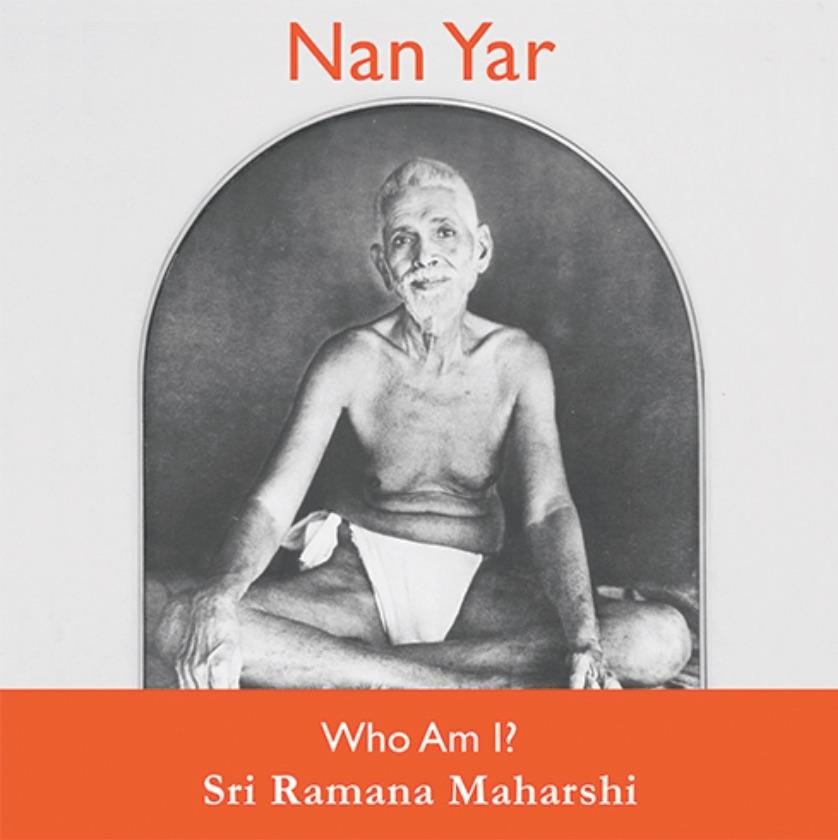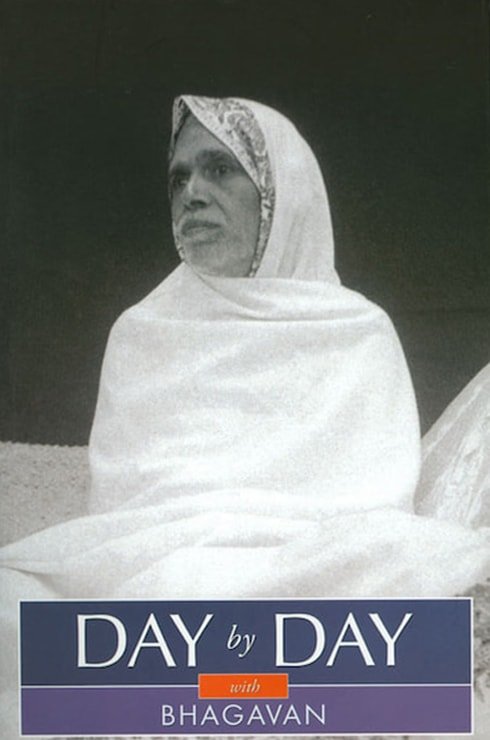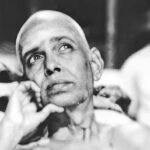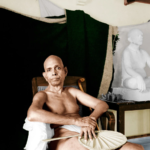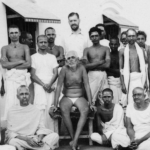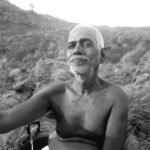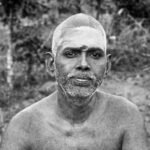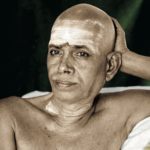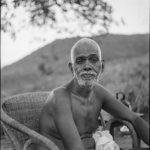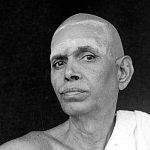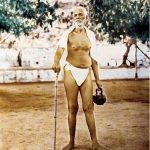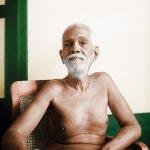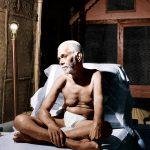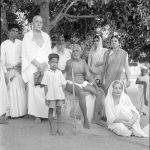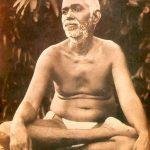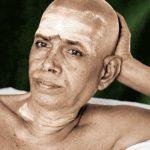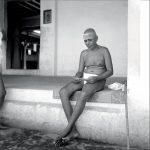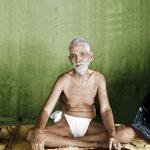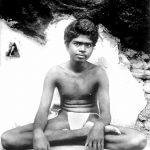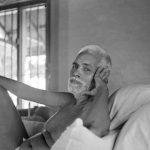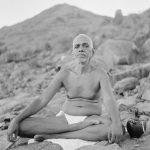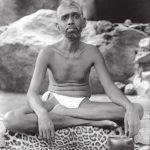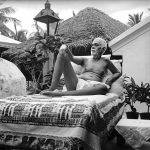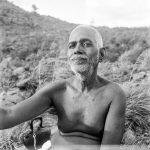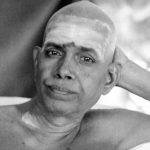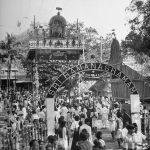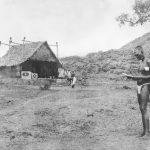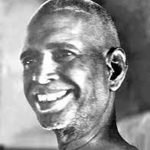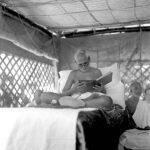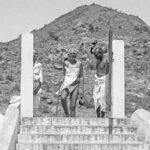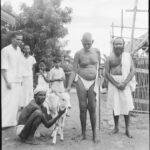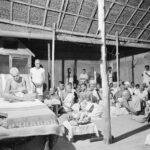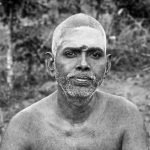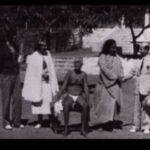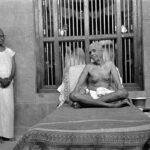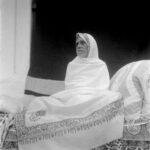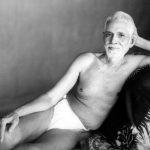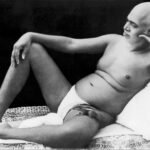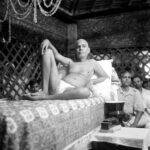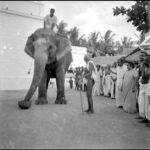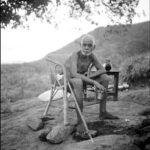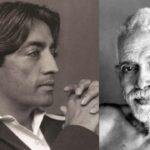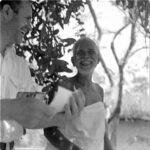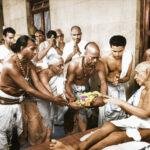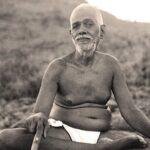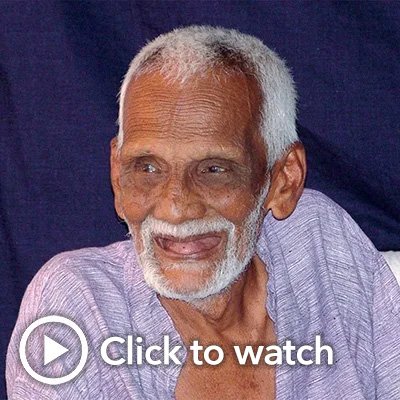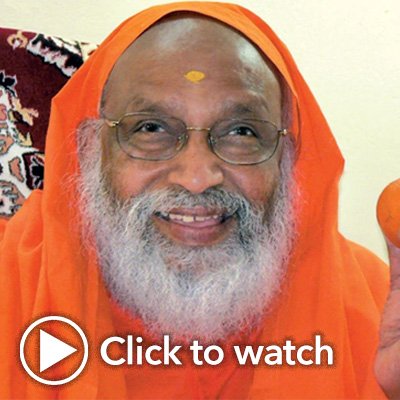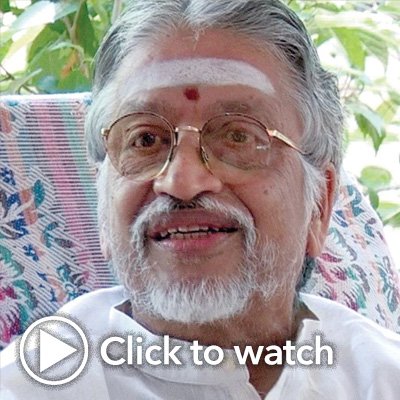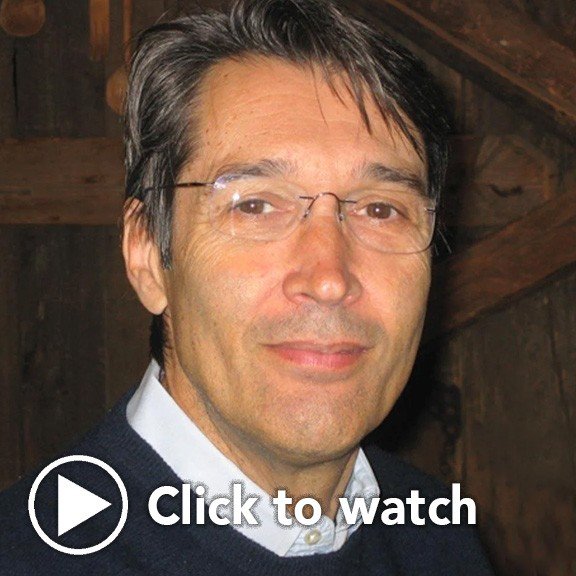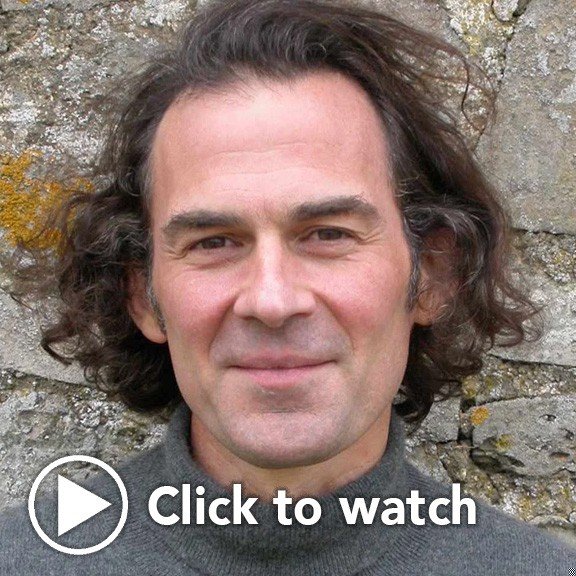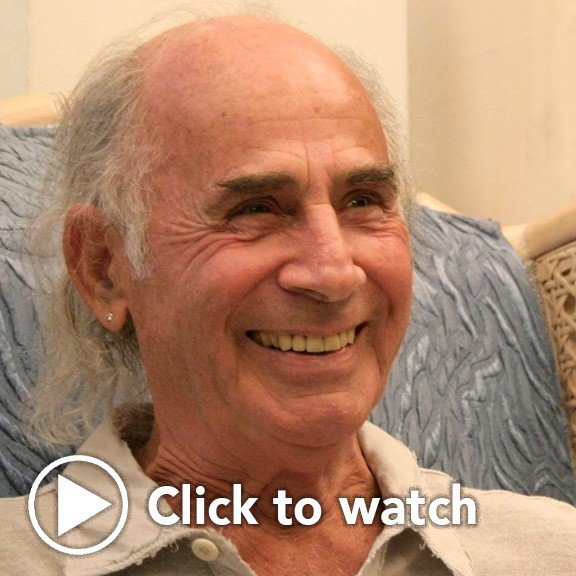Discover
Bhagavan
Sri Ramana Maharshi
Back to the Top
Who am I?
"Solve this great problem and you solve all other problems"
- Sri Ramana Maharshi
- Sri Ramana Maharshi
Ramana Maharshi Documentary
Ramana Maharshi Books in English
Aham Sphurana – A Glimpse of Self Realisation [Volume 1]
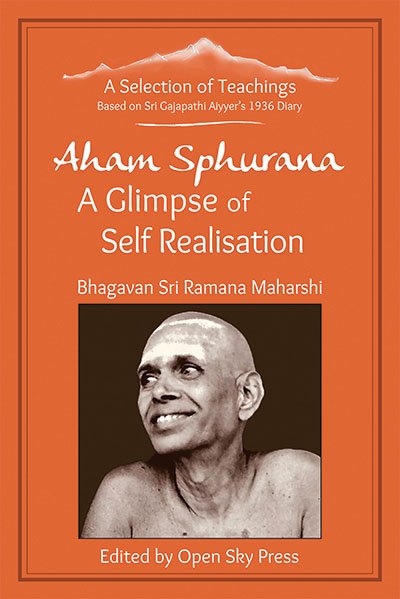
Fascinating dialogues and stories of Ramana Maharshi recorded by Sri Gajapathi Aiyyer in the summer 1936, at Ramana Ashram.
Vichara – Self Enquiry,
Who am I? [Volume 2]
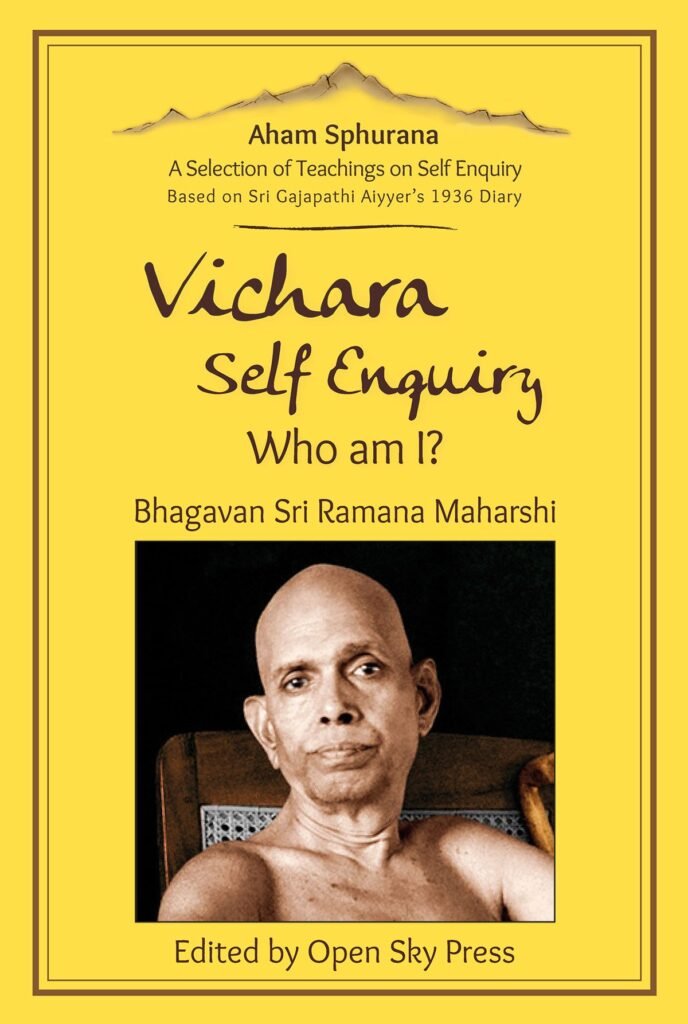
Vichara offers a fresh and focused exploration of Bhagavan Sri Ramana Maharshi’s most profound teaching: Self-enquiry.
Sharanagathi – Surrender,
Letting go. [Volume 3]
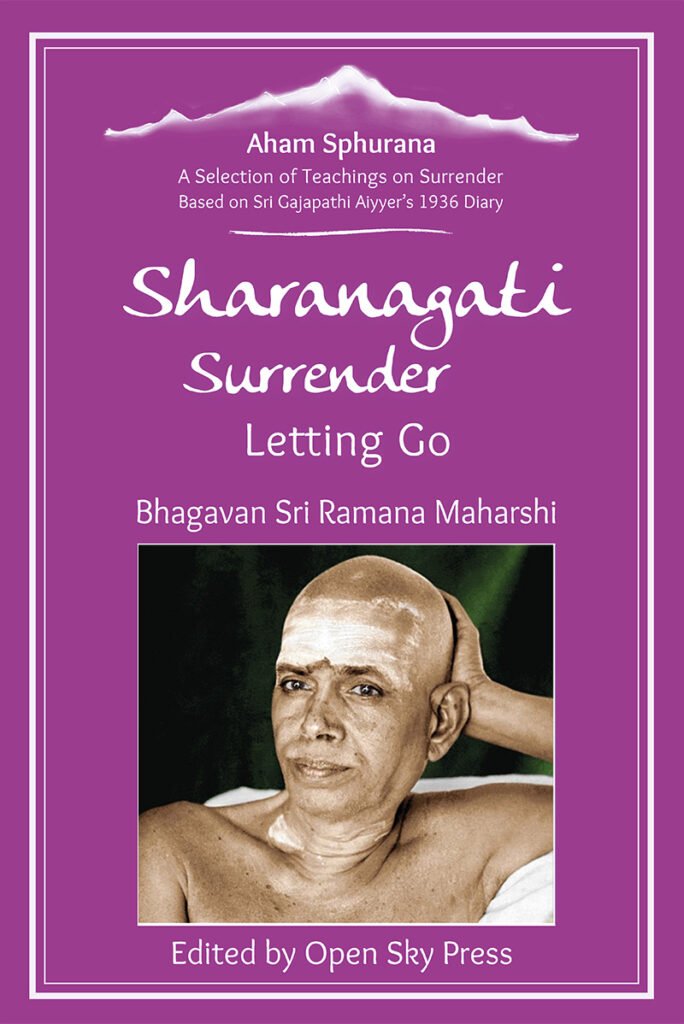
Sharanagathi explores Bhagavan’s direct and powerful path of dissolving the ego through surrender.
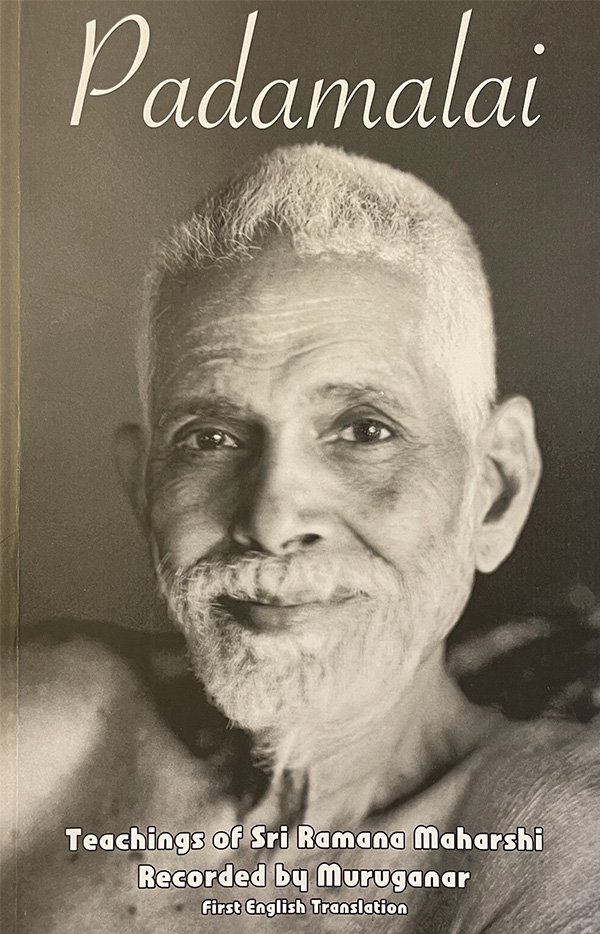
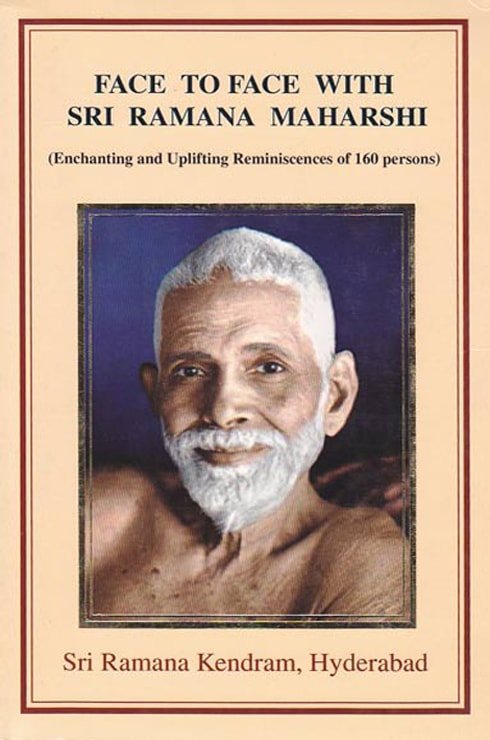
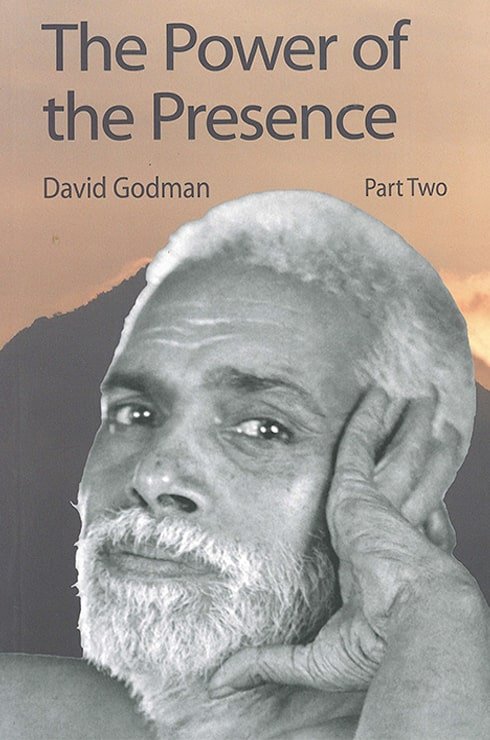
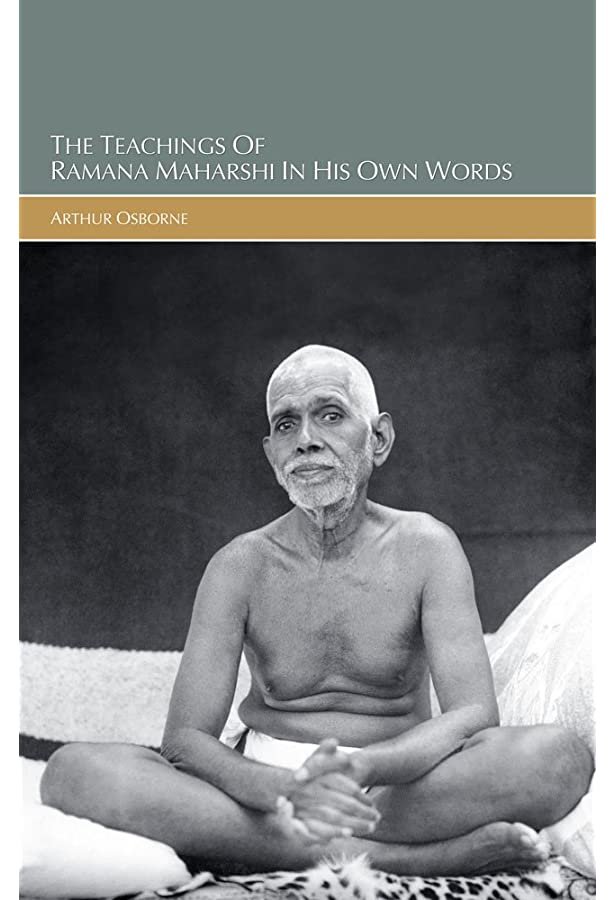

Ramana Maharshi Biography
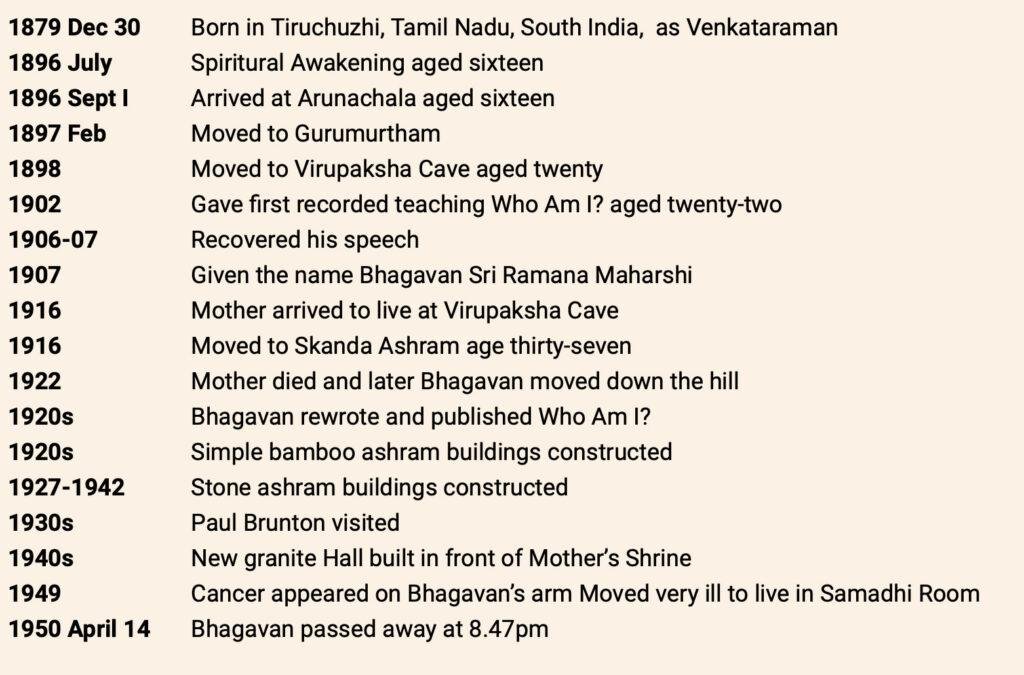
1879 Dec 30
1896 July
1896 Sept I
1897 Feb
1898
1902
1906-07
1907
1916
1916
1922
1920s
1920s
1927-1942
1930s
1940s
1949
1950 April 14
Born in Tiruchuzhi, Tamil Nadu, South India, as Venkataraman
Spiritural Awakening aged sixteen
Arrived at Arunachala aged sixteen
Moved to Gurumurtham
Moved to Virupaksha Cave aged twenty
Gave first recorded teaching Who Am I? aged twenty-two
Recovered his speech
Given the name Bhagavan Sri Ramana Maharshi
Mother arrived to live at Virupaksha Cave
Moved to Skanda Ashram age thirty-seven
Mother died and later Bhagavan moved down the hill
Bhagavan rewrote and published Who Am I?
Simple bamboо ashram buildings constructed
Stone ashram buildings constructed
Paul Brunton visited
New granite Hall built in front of Mother’s Shrine
Cancer appeared on Bhagavan’s arm Moved very ill to live in Samadhi Room
Bhagavan passed away at 8.47pm

Ramana's Awakening
In 1896 the 16-year-old boy Venkataraman challenged death by a penetrating enquiry into the source of his being. The following awakening intuitively led him to the holy mountain Arunachala in South India. Here he spent years of solitude meditating in temples and caves. Later in life he became known as Bhagavan Sri Ramana Maharshi and attracted many spiritual seekers to his ashram on the foothill of Arunachala mountain. Every visitor received teachings according to their own level of understanding and priority for freedom. Often, he would simply transmit his teachings through deep silence, or he would teach the method of Self-Enquiry.

“Just drop all seeking, turn your attention inward, and sacrifice your mind to the One Self radiating in the Heart of your very being.”
- Sri Ramana Maharshi
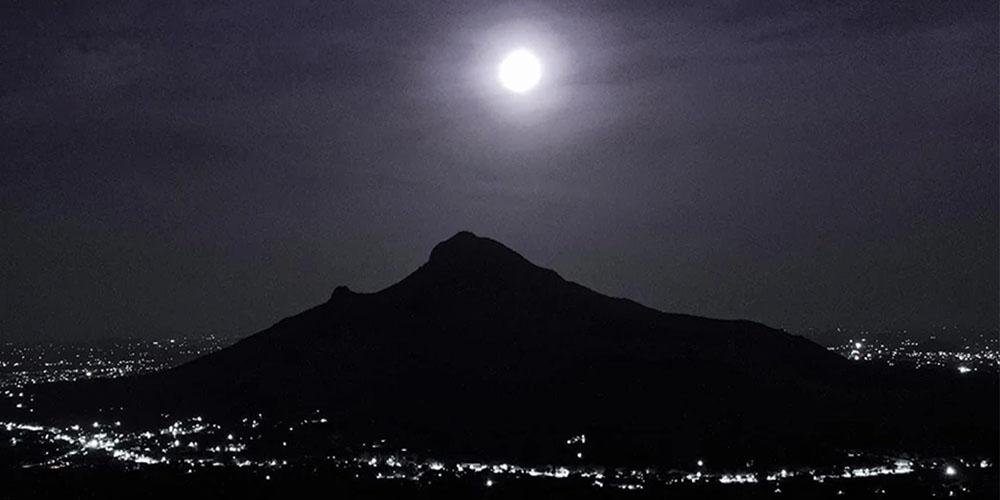
“Arunachala! You root out the ego of those who meditate on you in the heart. Oh Arunachala!"
- Sri Ramana Maharshi


Arunachala Drawing by Ramana Maharshi
Arunachala, oh holy mountain high,
A beacon of light that touches the sky,
In Tamil Nadu, your presence is felt,
A sacred abode where pilgrims melt.
Your peak so majestic, adorned with grace,
A source of wonder for those who trace,
The path that leads to your lofty peak,
A journey of faith that’s truly unique.
From Ramana’s cave to Girivalam’s round,
Devotees seek blessings that abound,
Arunachala, your power so vast,
Transforms lives, with every step they cast.
In the glow of the full moon’s light,
The hill shines bright, a mystical sight,
Arunachala, you hold the key,
To unlock the secrets of eternity.
Your name alone, a mantra so pure,
That touches hearts, and makes them sure,
That the divine resides in your soul,
Arunachala, you make us whole.
So we bow to you, with reverence and love,
And offer our prayers to the heavens above,
For Arunachala, you are the way,
To find the truth, and light our way.
Arunachala
Arunachala Mountain is one of five holy places dedicated to Shiva in South India. Sri Ramana Ashram is situated at its foothills. According to the legend Brahma and Vishnu were arguing over which one of them was superior. To settle the dispute Shiva entered and used his awesome powers to manifest as a column of light which then turned into the form of Arunachala.
Ramana Maharshi said that whereas other holy places such as Varanasi and Rishikesh are important abodes of Shiva, Arunachala Mountain is Shiva himself.
It is a place that provides true self-knowledge (jnana) and because this is not wanted by many people Arunachala remains relatively unknown. To those who truly seek knowledge of the Self, this mountain will always make itself known through one way or the other.
Every year in January, John David offers an intensive Retreat at the feet of the holy hill.
The Teachings of Sri Ramana Maharshi
Self Enquiry: Bringing the Mind Back to the Self
Self-Enquiry is in the words of Ramana Maharshi “the most sacred of sacred.” It is indeed a radical spiritual method. Ramana has explained why this practice is singularly effective: “What is essential in any sadhana [spiritual practice] is to try to bring back the running mind and fix it on one thing only. Why then should it not be brought back and fixed in Self-attention? That alone is Self-Enquiry. That is all that is to be done!”
This question of “Who am I?” comes from a space of deep Stillness, and is also nurtured from the same silence which sometimes spontaneously appear in our mind and in our being. In this way there can occur an instant inner recognition of who we really are.

“The only useful purpose of the present birth is to turn within and realize the Self”
- Sri Ramana Maharshi
Original Teachings from 1936
Rooting Out the Ego and Persevering on the Path
Root out ego directly, persevere endlessly despite obstacles, and realise you never left the summit of pure Being.
Danger of Emptiness [shunyastithi]
Bhagavan warns that mistaking emptiness for Jnana is a deadly trap, delaying true realization and making recovery a challenging path.
BE As You Are
Realization is simply BEing as you ARE. Through persistent vichara, Grace shines forth until seeker and seeking both dissolve.
Ripe Souls Attain Jnana
The Jnani’s silent presence works like a magnetic force, effortlessly turning ripe minds inward, leading to natural, thought-free peace.
How we Sabotage Vichara
Sabotage ends when we discard the ‘I’ that strives for Realisation, resting in pure Subjective Consciousness, free from identification.
Am I doing Vichara Correctly?
Correct vichara is confirmed when Aham Sphurana shines forth spontaneously, unmistakably felt as direct experience of the Self.
Sex and the Self
Sex offers a taste of no-mind bliss, creating addiction as the ego craves this momentary experience of pure Being.
Complete Cessation of Mental Activity
Only the complete, motiveless cessation of mental activity reveals the Self, showing the personal ‘I’ never truly existed.
The Secret of Jnana is Bhakti
Jnana is Bhakti: Pure, uncaused Love. Not practised, but revealed when thoughts dissolve, merging seeker and Love as One.
Essential Extracts from the Manuscript
Aham Sphurana is a beacon leading to Sahaja, but only when left undisturbed and ego-free, allowing spontaneous abidance.
A Former Classmate Visiting Bhagavan
A touching reunion of childhood friends highlights Bhagavan’s humility, refusal of special gifts, and unconditional compassion for all.
Mrs Piggot’s Diary
Mrs. Piggot recounts her farewell to Bhagavan, highlighting his quiet knowing, grace, and teaching to live as the Self.
A Dialogue with a Mature Visiter
Bhagavan guides a seeker beyond concepts, showing that diligent Self-inquiry removes doubt and ignorance, revealing the timeless Self.
Schopenhauer and Renunciation
Schopenhauer exposes life’s futility, but true renunciation and surrender arise from Grace, dissolving ego and revealing the Self.
A Small Wise Boy
Through a boy’s spinning top, Bhagavan reveals that prarabdha spins itself out naturally, beyond the Jnani’s identification.
The Juggler
Through a juggler’s display, Bhagavan emphasizes focusing inward, relinquishing belief and ego, to realize the Self beyond all spectacle.
How shall we kill the mind?
The mind cannot kill itself. Seeking its source and ignoring objects dissolve it, revealing the Heart as stillness.
Sri Gajapathi Aiyyer Ashram Report
A vivid Ashram diary recounting the devoted, diverse lives of seekers, Bhagavan’s humour, Grace, and timeless wisdom in action.
Trust in God
Bhagavan reminds people to trust in God for its needs, resolving a misunderstanding with compassion and integrity.
Reference Books and Translation
Bhagavan spoke many languages, quoted texts with precision, and used interpreters as needed, making profound teaching universally accessible.
Love Is
Bhagavan teaches that unselfish, motiveless Love is the essence of Jnana, with vichara being a path to reveal it.
Letters to Bhagavan
Letters to Bhagavan, answered by a Brahmin scribe, carried the Master’s imprimatur, preserving his teaching and direct spiritual essence.
40th Anniversary Event
The 40th anniversary of Bhagavan’s union with Arunachala was celebrated with reverence, and grace, with him attending to every detail.
Vishwanatha Aiyyer and the Monkey
Bhagavan recounts how the monkey Shabarigirisan miraculously inspired a boy to return home, illustrating the mysterious grace of Arunachala.
Obstacles which Hinder Realisation of the Self.
Realisation is hindered by habits of thought; overcome by tracing thoughts to their source and resting in pure, timeless Being.
Sri Gajapathi Healed and Attacked
Through Grace, Love, and remembrance, illness was healed, fear dissolved, and an enduring devotion to Bhagavan and Hanuman remained.
A Dog and A Monkey
Through Grace and surrender, one is lifted beyond samsara, like the monkey safe from the barking dog, untouched.
Mrs. Piggot Introduces the Ashram And Bhagavan’s Meetings in 1934
Mrs. Piggot recounts her serene visit with Sri Ramana Maharshi, describing the Sage’s profound silence, grace, and life-changing presence.
A Typical Western Visitor’s In-Depth Dialogue with Bhagavan
Through patient dialogue, Sri Ramana guides a seeker towards Self‑Realization, emphasizing grace, inquiry, inner silence, and simple vegetarianism.
The Aghori Sadhu Life Story
Through a lifetime of hardships, rituals, and encounters with saints, the Aghori finds the grace of Ramana Maharshi, surrendering ego and discovering the peace of the Self.
Mr. Evans-Wentz’s Visit
A visitor finds peace and wisdom with Ramana Maharshi, experiences deep spiritual moments, and departs with profound gratitude and joy.
The Play Around Bhagavan
A devotee recounts a miraculous night with Ramana Maharshi and an Aghori, highlighting surrender, grace, and the path to Self-realisation.
Libelling Bhagavan
A manager reports a slanderer’s misdeeds, but Bhagavan, serene and detached, laughs, accepting all as part of divine play.
The Heart
The spiritual heart shines forth when effort and doing subside, thoughts dissolve, and natural stillness becomes the only state.
Non-Doing
Self‑Realisation is not achieved by doing, effort, or thought, but by naturally subsiding into stillness beyond all mental activity.
Sri Gajapathi Aiyyer, Author of Aham Spraruna
Gajapathi Aiyyer’s Red Notebooks preserve Bhagavan’s profound teachings, offering timeless guidance for seekers, now published and accessible to all.
The Aghori’s Death and Liberation
Bhagavan guides the Aghori’s death with serene grace, ensuring sacred release and merging the sadhu’s being with the Absolute.
Kaushika
Kaushika’s pride is humbled by a housewife and butcher, teaching that surrender and dutiful living lead to true realization.
An Incident between Bhagavan and the Ashram Manager
Bhagavan compassionately scolds the manager for cruelty towards rats, teaching mercy and the value of every life, inspiring humility.
Ramana Maharshi on Jesus Teachings
Bhagavan explains Jesus’ words as Advaitic teaching, guiding the seeker towards Self-Realization, surrender, and a still, inward-turned mind.
Surrender
Ramana Maharshi explains that unconditional surrender means total letting go, making Self-Realization inevitable, beyond thoughts, conditions, or expectations.
Renunciation
Ramana Maharshi explains that renunciation burns tendencies, leading to effortless stillness and ultimate merging of the mind into the Heart.
Only the Self, No God
Ramana Maharshi explains that God is real only while ego exists; the Jnani rests as the Self, acting spontaneously, free.
Illusion and the Body
Ramana Maharshi explains that you are pure awareness, not the body. The world is a mental projection of the Self.
The Count
Ramana Maharshi guides a seeker troubled by sex, guilt, and sin to overcome ego through the ‘Who am I?’ inquiry.
Unrealise the not-Self
Recognise that all ideas of ego and identity are unreal, and by seeing this clearly, only the true Self remains.
Jaws of the Tiger
The ego is like a goat caught in the tiger’s jaws of Grace, and no matter how long it struggles, its end — total annihilation — is certain.
Samadhi
Samadhi is the natural state where ego, thoughts, and effort dissolve, leaving only pure Being — the Self — revealed.
Realise the Self
Realisation occurs when one surrenders completely, lets go of ego, embraces silence, and abides as the timeless, changeless Self.
Gossip
Chadwick recounts a miracle New York visit, illustrating Grace beyond space, attachment, and the inward path to formlessness.
Destiny
Ramana Maharshi teaches that regardless of destiny, ego’s illusions must be dissolved inwardly for true Self-Realization and freedom.
I have a body
Ramana Maharshi explains that regardless of thoughts about the body, one must abide as the Self, allowing life to flow spontaneously.
Consciousness
The “I”-sense is not even remotely connected to anything physical. Being of the nature of consciousness, it emanates from the Self only.
J.Krishnamurti’s, Dissolution of the Order of the Star
Krishnamurti dissolves the Order of the Star, affirming truth is pathless and self‑discovered, beyond organizations, leaders, or authority.
What is the Purpose of Life?
Life does not question its own purpose. It has no questions to ask. It has no complaint to raise. It has no grudge to bear.
Guru’s Grace
Ramana Maharshi explains that Guru’s Grace burns ego and mental habits, allowing total surrender and spontaneous Self-Realization to arise.
The Answer is to Enquire,”Who Am I”
Through playful enquiry and timeless teaching, Ramana Maharshi guides a seeker from ego and fear to the Self’s silence.
Vichara, Self Enquiry
Ramana Maharshi guides Chadwick and seekers to practice vichara, deep self-enquiry, until ego dissolves and the Self shines forth.
Meditation
Meditation means sticking to one thought to the exclusion of every other. One particular thought keeps away all others.
Day by Day with a Jnani
Ramana Maharshi exposes the ego’s illusion, guiding seekers to drop belief in the personal self and rest as timeless Being.
Summa Iru
Summa Iru means resting quietly, free from thought and activity, allowing the mind to dissolve and reveal natural peace.
Commentaries on Bhagavan's Teachings
Interviews with Indian and Western Masters on Bhagavan's teachings
During his travels in India and throughout Europe, John David met and interviewed sixteen spiritual masters from India and dozens from the west, capturing unique dialogues about Ramana Maharshi’s teachings. These encounters were filmed and transcribed for the book series Blueprints for Awakening, as part of a search for deeper understanding of the great Indian Saint’s wisdom. Each Master was asked 12 questions. This archive collects the answers each Master has given.
You can watch the 1-2hour interviews by clicking on the photos.
John David’s Connection to Ramana Maharshi
“Bhagavan Sri Ramana Maharshi came into my life quietly, imperceptibly, through a photograph twenty years ago, and has become a central inspiration in my life.
Thank you for the exemplary life you led and for the simplicity and clarity with which you guide us. The question “Who am I?” has provided a golden key to all who wish to know their essential nature.”
– John David
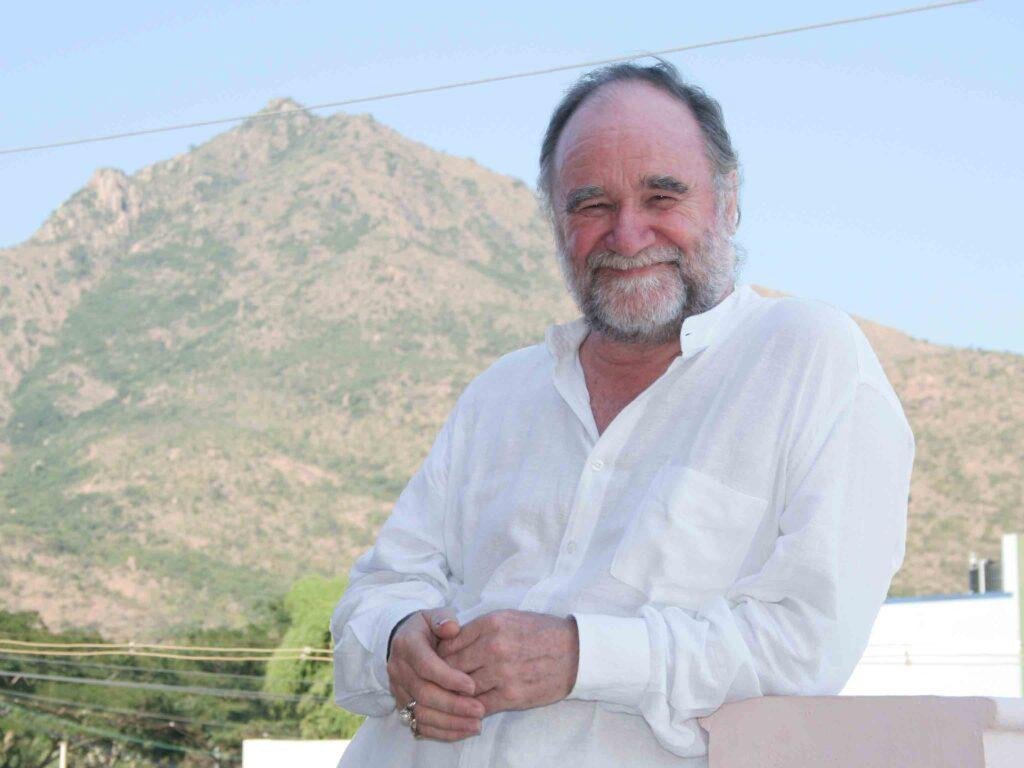
Sri Ramana Maharshi was the teacher of John David’s Indian teacher Papaji. So, it is natural that John David considers Ramana his own root teacher. For 20 years he has conducted a January retreat near Arunachala mountain, and it has been an excellent way to continuously revitalise his heartfelt connection to Ramana.
John David finds Self-Enquiry to be the most direct way of giving spiritual seekers a spontaneous glimpse of the True Self. During retreats John David often dedicates a whole day to intense practice of Self-Enquiry. Participants sit together face to face and ask each other “Who are you?”. Over time that all conceptual answers to the question falls away and a monumental silence permeates the entire room.
Annual Arunachala Pilgrimage Retreat
A Remarkable Retreat with John David at the holy Mountain Arunachala in South India
Retreat Trailer
Practicalities
Prices:
2350€ Standard
1850€ Concession
1200€ Young Helpers (talk to Indira)
Travel: Chennai or Bangalore in South India, from there 3-5 hour Taxi ride to Tiruvannamalai, at the foot of Arunachala
Contact: Indira
Mobile and Whatsapp: +49 (0)178 289 0814
Email: office@johndavidsatsang.international
10th – 30th January 2026
John David’s deep connection to Sri Ramana Maharshi has drawn him back time and again to the sacred Arunachala Mountain. For the 25th time, he offers a 3-week retreat in this most auspicious of places.
John David will guide us to explore Self Enquiry and introduce us to the wisdom of ancient India. He will provide a supportive and safe retreat environment in which the presence of the Self can touch you at anytime and lead to profound inner transformation. The retreat will take place with a group of about 30 participants, in a small, tranquil ashram, just 10 minutes from the renowned Ramana Ashram. The mountain, which has been a sacred destination for pilgrims for over two thousand years, drew the young Ramana Maharshi after his profound Self-Realisation.

